Strategic Management Report: Evaluating Issues, Models, and Practices
VerifiedAdded on 2019/12/28
|12
|3357
|286
Report
AI Summary
This report delves into the multifaceted realm of strategic management, examining its core components and practical applications. It begins by evaluating key issues such as leadership, stakeholder management, environmental scanning, globalization, and technology's impact on business strategies. The report then explores a range of theoretical models, including SWOT analysis, Porter's Five Forces, Porter's Generic Strategies, the Value Chain Model, PESTLE analysis, and Core Competence, providing insights into their application and significance. Furthermore, the report critically reviews strategic management practices such as human resource policies, customer retention strategies, promotional strategies, and pricing strategies, highlighting their importance in achieving organizational goals. The report offers a comprehensive overview of the strategies and models used in the field of strategic management.
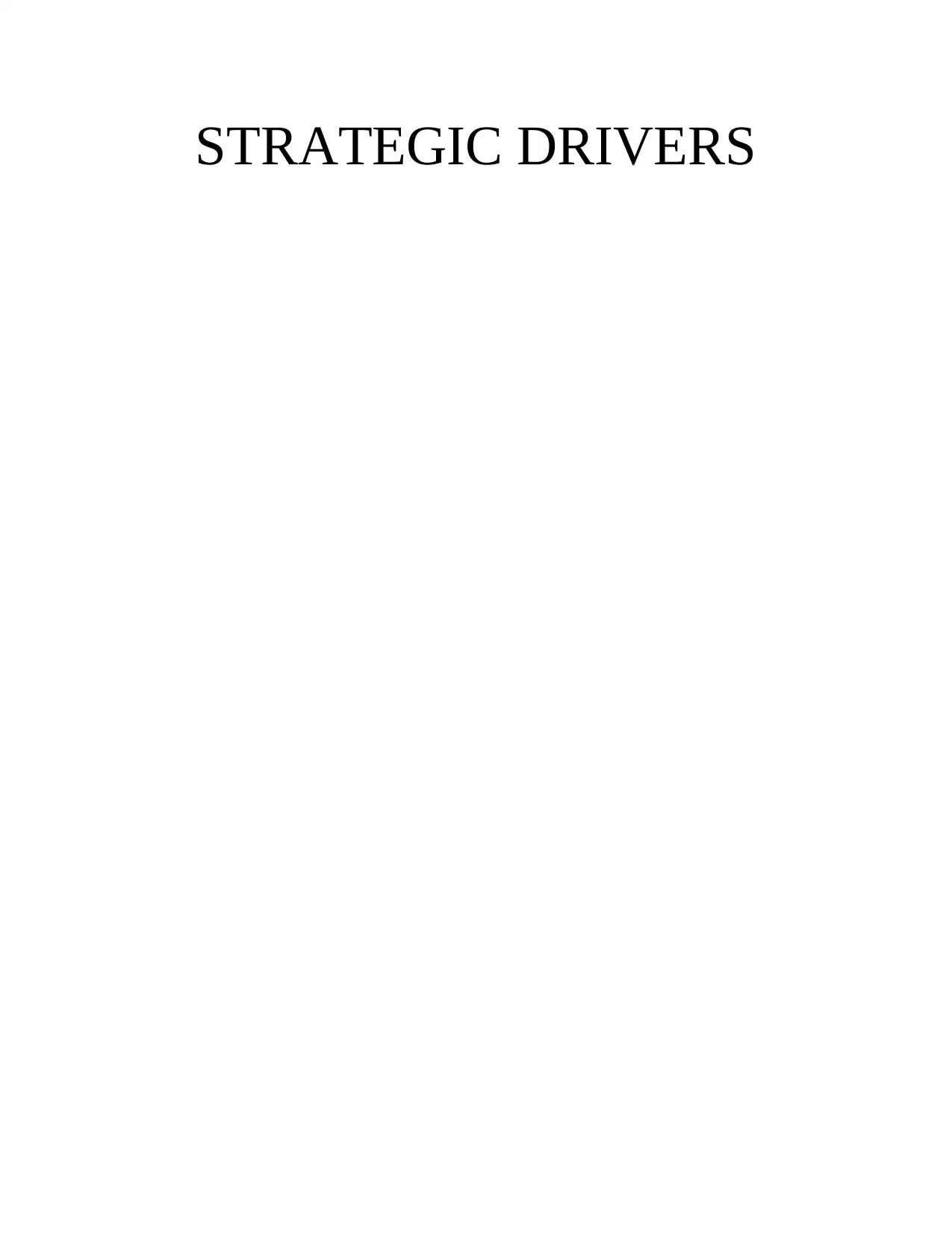
STRATEGIC DRIVERS
Paraphrase This Document
Need a fresh take? Get an instant paraphrase of this document with our AI Paraphraser
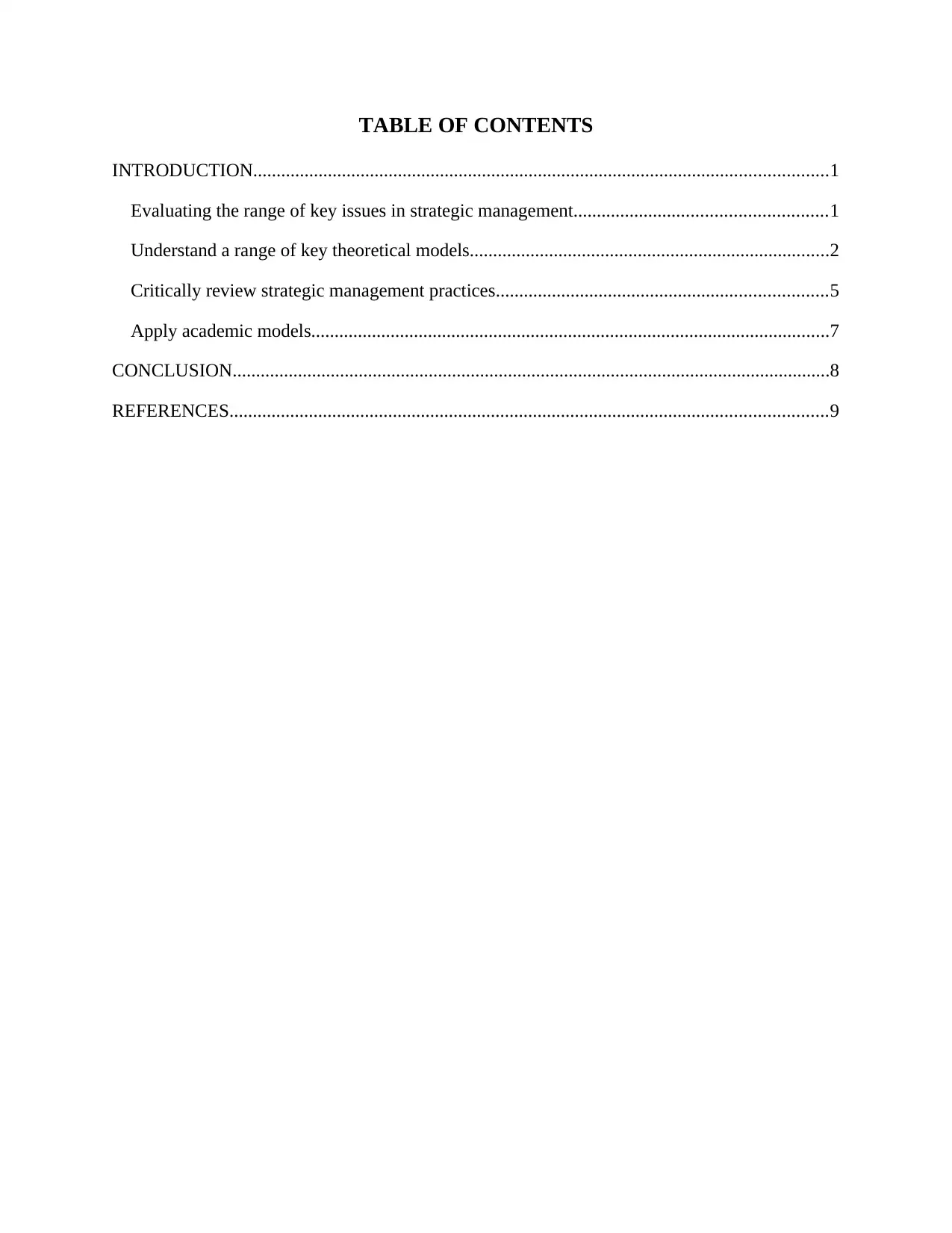
TABLE OF CONTENTS
INTRODUCTION...........................................................................................................................1
Evaluating the range of key issues in strategic management......................................................1
Understand a range of key theoretical models.............................................................................2
Critically review strategic management practices.......................................................................5
Apply academic models...............................................................................................................7
CONCLUSION................................................................................................................................8
REFERENCES................................................................................................................................9
INTRODUCTION...........................................................................................................................1
Evaluating the range of key issues in strategic management......................................................1
Understand a range of key theoretical models.............................................................................2
Critically review strategic management practices.......................................................................5
Apply academic models...............................................................................................................7
CONCLUSION................................................................................................................................8
REFERENCES................................................................................................................................9
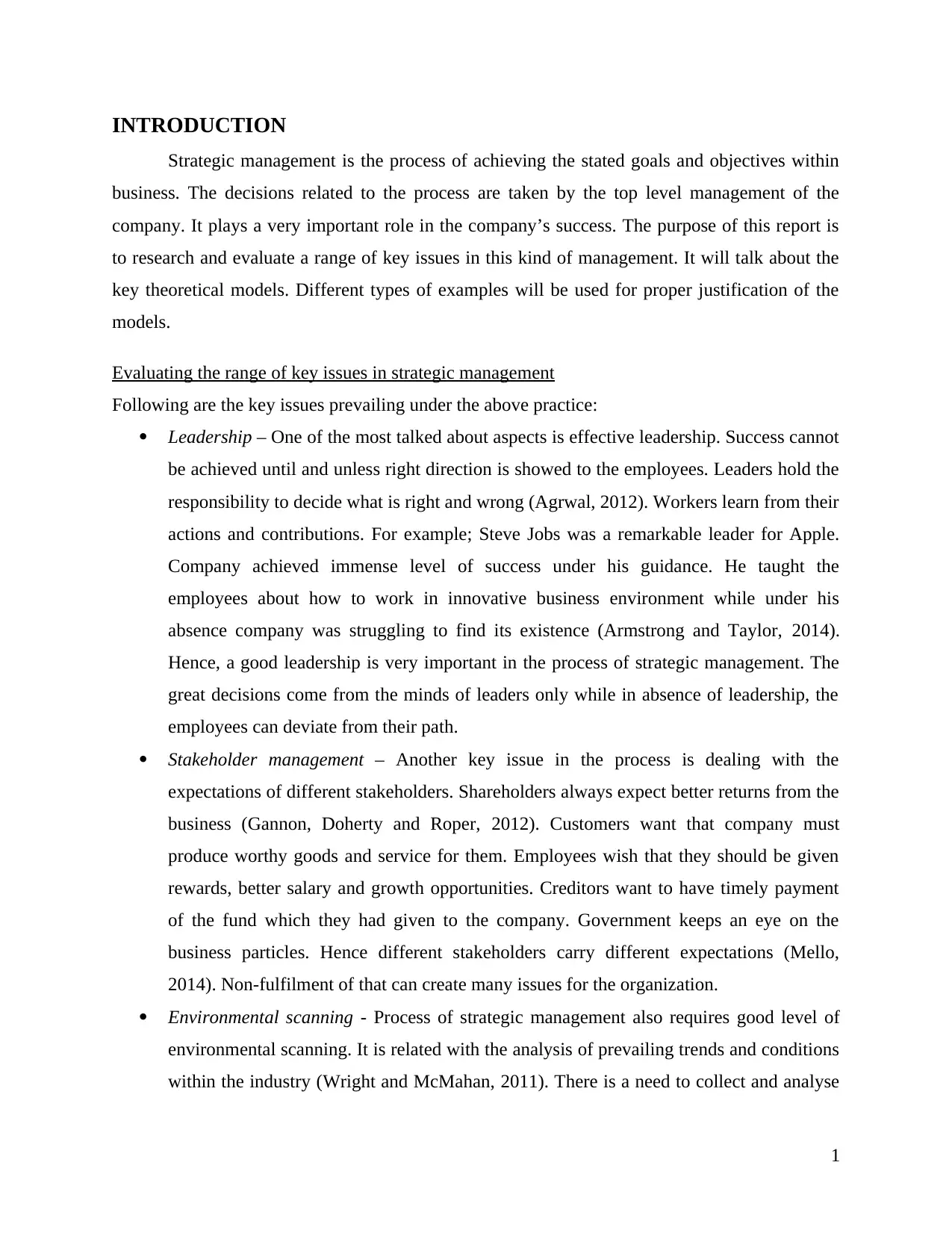
INTRODUCTION
Strategic management is the process of achieving the stated goals and objectives within
business. The decisions related to the process are taken by the top level management of the
company. It plays a very important role in the company’s success. The purpose of this report is
to research and evaluate a range of key issues in this kind of management. It will talk about the
key theoretical models. Different types of examples will be used for proper justification of the
models.
Evaluating the range of key issues in strategic management
Following are the key issues prevailing under the above practice:
Leadership – One of the most talked about aspects is effective leadership. Success cannot
be achieved until and unless right direction is showed to the employees. Leaders hold the
responsibility to decide what is right and wrong (Agrwal, 2012). Workers learn from their
actions and contributions. For example; Steve Jobs was a remarkable leader for Apple.
Company achieved immense level of success under his guidance. He taught the
employees about how to work in innovative business environment while under his
absence company was struggling to find its existence (Armstrong and Taylor, 2014).
Hence, a good leadership is very important in the process of strategic management. The
great decisions come from the minds of leaders only while in absence of leadership, the
employees can deviate from their path.
Stakeholder management – Another key issue in the process is dealing with the
expectations of different stakeholders. Shareholders always expect better returns from the
business (Gannon, Doherty and Roper, 2012). Customers want that company must
produce worthy goods and service for them. Employees wish that they should be given
rewards, better salary and growth opportunities. Creditors want to have timely payment
of the fund which they had given to the company. Government keeps an eye on the
business particles. Hence different stakeholders carry different expectations (Mello,
2014). Non-fulfilment of that can create many issues for the organization.
Environmental scanning - Process of strategic management also requires good level of
environmental scanning. It is related with the analysis of prevailing trends and conditions
within the industry (Wright and McMahan, 2011). There is a need to collect and analyse
1
Strategic management is the process of achieving the stated goals and objectives within
business. The decisions related to the process are taken by the top level management of the
company. It plays a very important role in the company’s success. The purpose of this report is
to research and evaluate a range of key issues in this kind of management. It will talk about the
key theoretical models. Different types of examples will be used for proper justification of the
models.
Evaluating the range of key issues in strategic management
Following are the key issues prevailing under the above practice:
Leadership – One of the most talked about aspects is effective leadership. Success cannot
be achieved until and unless right direction is showed to the employees. Leaders hold the
responsibility to decide what is right and wrong (Agrwal, 2012). Workers learn from their
actions and contributions. For example; Steve Jobs was a remarkable leader for Apple.
Company achieved immense level of success under his guidance. He taught the
employees about how to work in innovative business environment while under his
absence company was struggling to find its existence (Armstrong and Taylor, 2014).
Hence, a good leadership is very important in the process of strategic management. The
great decisions come from the minds of leaders only while in absence of leadership, the
employees can deviate from their path.
Stakeholder management – Another key issue in the process is dealing with the
expectations of different stakeholders. Shareholders always expect better returns from the
business (Gannon, Doherty and Roper, 2012). Customers want that company must
produce worthy goods and service for them. Employees wish that they should be given
rewards, better salary and growth opportunities. Creditors want to have timely payment
of the fund which they had given to the company. Government keeps an eye on the
business particles. Hence different stakeholders carry different expectations (Mello,
2014). Non-fulfilment of that can create many issues for the organization.
Environmental scanning - Process of strategic management also requires good level of
environmental scanning. It is related with the analysis of prevailing trends and conditions
within the industry (Wright and McMahan, 2011). There is a need to collect and analyse
1
⊘ This is a preview!⊘
Do you want full access?
Subscribe today to unlock all pages.

Trusted by 1+ million students worldwide
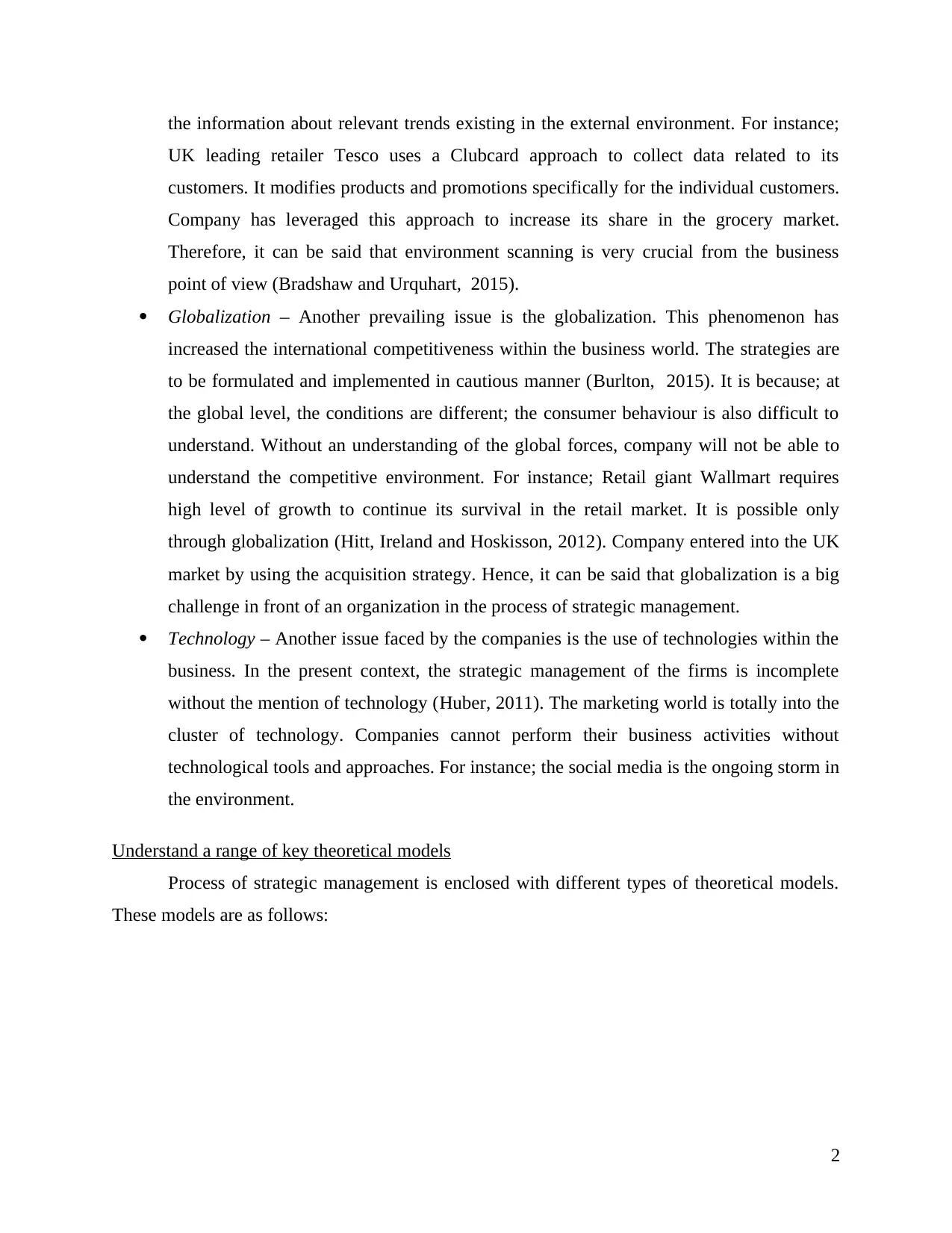
the information about relevant trends existing in the external environment. For instance;
UK leading retailer Tesco uses a Clubcard approach to collect data related to its
customers. It modifies products and promotions specifically for the individual customers.
Company has leveraged this approach to increase its share in the grocery market.
Therefore, it can be said that environment scanning is very crucial from the business
point of view (Bradshaw and Urquhart, 2015).
Globalization – Another prevailing issue is the globalization. This phenomenon has
increased the international competitiveness within the business world. The strategies are
to be formulated and implemented in cautious manner (Burlton, 2015). It is because; at
the global level, the conditions are different; the consumer behaviour is also difficult to
understand. Without an understanding of the global forces, company will not be able to
understand the competitive environment. For instance; Retail giant Wallmart requires
high level of growth to continue its survival in the retail market. It is possible only
through globalization (Hitt, Ireland and Hoskisson, 2012). Company entered into the UK
market by using the acquisition strategy. Hence, it can be said that globalization is a big
challenge in front of an organization in the process of strategic management.
Technology – Another issue faced by the companies is the use of technologies within the
business. In the present context, the strategic management of the firms is incomplete
without the mention of technology (Huber, 2011). The marketing world is totally into the
cluster of technology. Companies cannot perform their business activities without
technological tools and approaches. For instance; the social media is the ongoing storm in
the environment.
Understand a range of key theoretical models
Process of strategic management is enclosed with different types of theoretical models.
These models are as follows:
2
UK leading retailer Tesco uses a Clubcard approach to collect data related to its
customers. It modifies products and promotions specifically for the individual customers.
Company has leveraged this approach to increase its share in the grocery market.
Therefore, it can be said that environment scanning is very crucial from the business
point of view (Bradshaw and Urquhart, 2015).
Globalization – Another prevailing issue is the globalization. This phenomenon has
increased the international competitiveness within the business world. The strategies are
to be formulated and implemented in cautious manner (Burlton, 2015). It is because; at
the global level, the conditions are different; the consumer behaviour is also difficult to
understand. Without an understanding of the global forces, company will not be able to
understand the competitive environment. For instance; Retail giant Wallmart requires
high level of growth to continue its survival in the retail market. It is possible only
through globalization (Hitt, Ireland and Hoskisson, 2012). Company entered into the UK
market by using the acquisition strategy. Hence, it can be said that globalization is a big
challenge in front of an organization in the process of strategic management.
Technology – Another issue faced by the companies is the use of technologies within the
business. In the present context, the strategic management of the firms is incomplete
without the mention of technology (Huber, 2011). The marketing world is totally into the
cluster of technology. Companies cannot perform their business activities without
technological tools and approaches. For instance; the social media is the ongoing storm in
the environment.
Understand a range of key theoretical models
Process of strategic management is enclosed with different types of theoretical models.
These models are as follows:
2
Paraphrase This Document
Need a fresh take? Get an instant paraphrase of this document with our AI Paraphraser
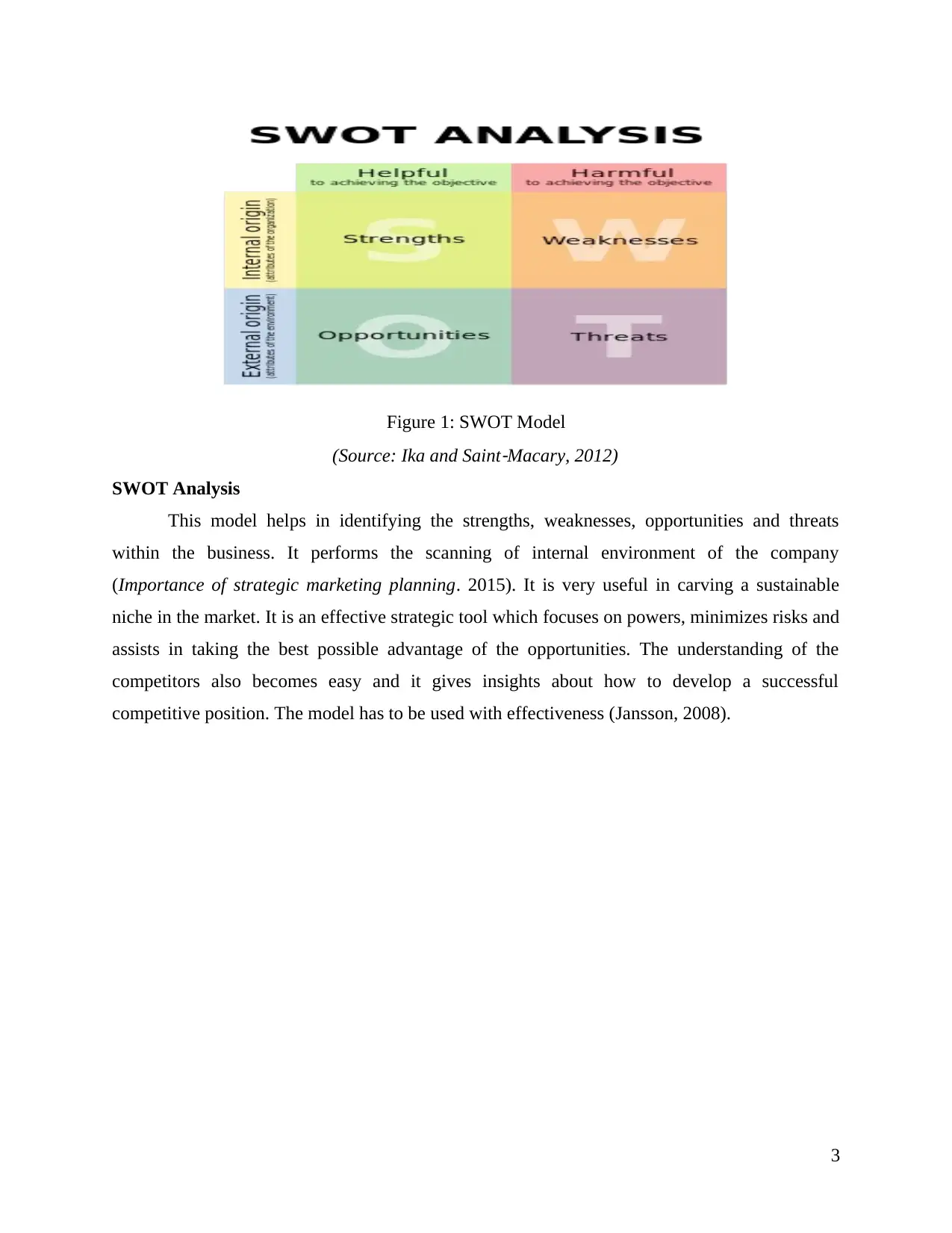
Figure 1: SWOT Model
(Source: Ika and Saint
‐Macary, 2012)
SWOT Analysis
This model helps in identifying the strengths, weaknesses, opportunities and threats
within the business. It performs the scanning of internal environment of the company
(Importance of strategic marketing planning. 2015). It is very useful in carving a sustainable
niche in the market. It is an effective strategic tool which focuses on powers, minimizes risks and
assists in taking the best possible advantage of the opportunities. The understanding of the
competitors also becomes easy and it gives insights about how to develop a successful
competitive position. The model has to be used with effectiveness (Jansson, 2008).
3
(Source: Ika and Saint
‐Macary, 2012)
SWOT Analysis
This model helps in identifying the strengths, weaknesses, opportunities and threats
within the business. It performs the scanning of internal environment of the company
(Importance of strategic marketing planning. 2015). It is very useful in carving a sustainable
niche in the market. It is an effective strategic tool which focuses on powers, minimizes risks and
assists in taking the best possible advantage of the opportunities. The understanding of the
competitors also becomes easy and it gives insights about how to develop a successful
competitive position. The model has to be used with effectiveness (Jansson, 2008).
3
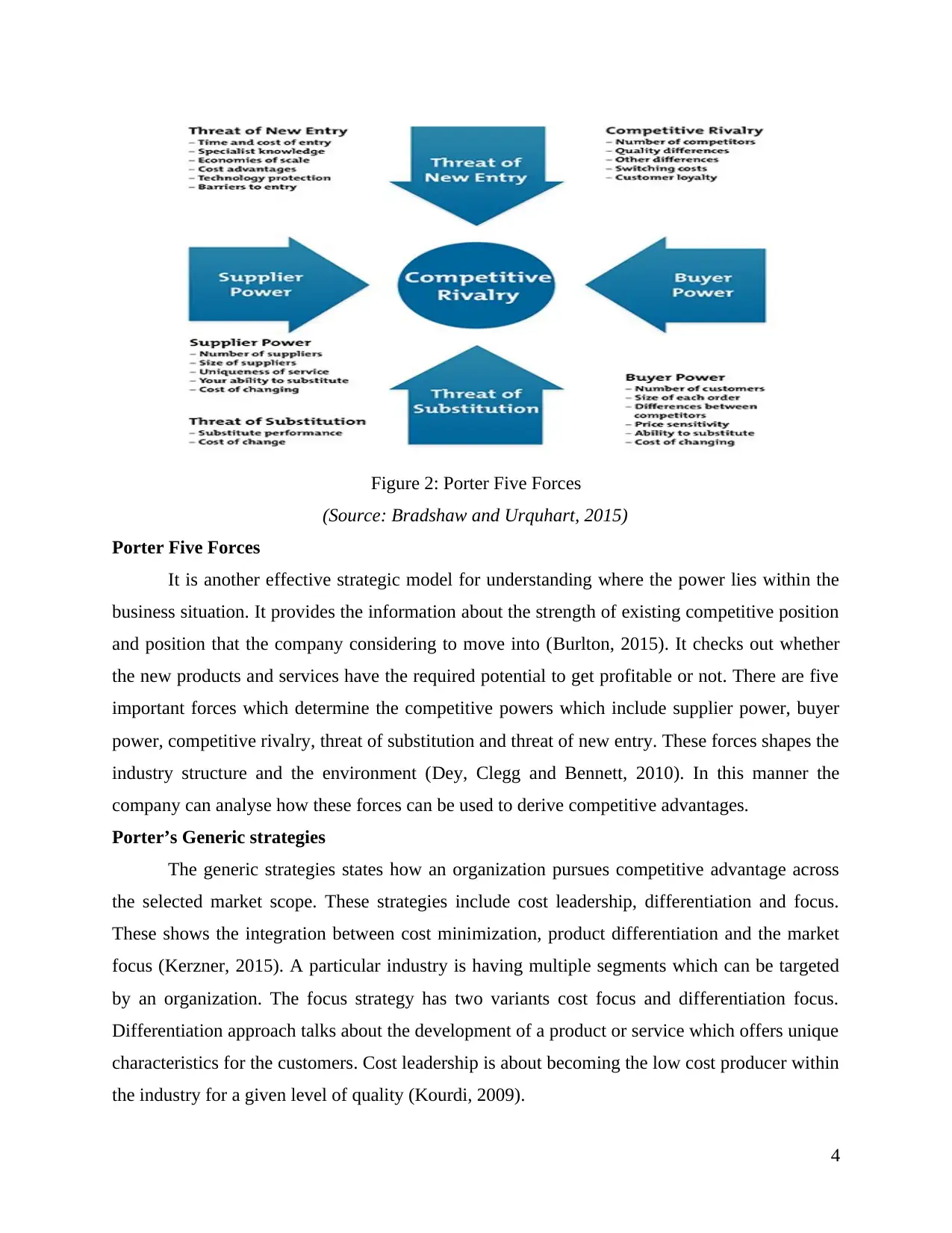
Figure 2: Porter Five Forces
(Source: Bradshaw and Urquhart, 2015)
Porter Five Forces
It is another effective strategic model for understanding where the power lies within the
business situation. It provides the information about the strength of existing competitive position
and position that the company considering to move into (Burlton, 2015). It checks out whether
the new products and services have the required potential to get profitable or not. There are five
important forces which determine the competitive powers which include supplier power, buyer
power, competitive rivalry, threat of substitution and threat of new entry. These forces shapes the
industry structure and the environment (Dey, Clegg and Bennett, 2010). In this manner the
company can analyse how these forces can be used to derive competitive advantages.
Porter’s Generic strategies
The generic strategies states how an organization pursues competitive advantage across
the selected market scope. These strategies include cost leadership, differentiation and focus.
These shows the integration between cost minimization, product differentiation and the market
focus (Kerzner, 2015). A particular industry is having multiple segments which can be targeted
by an organization. The focus strategy has two variants cost focus and differentiation focus.
Differentiation approach talks about the development of a product or service which offers unique
characteristics for the customers. Cost leadership is about becoming the low cost producer within
the industry for a given level of quality (Kourdi, 2009).
4
(Source: Bradshaw and Urquhart, 2015)
Porter Five Forces
It is another effective strategic model for understanding where the power lies within the
business situation. It provides the information about the strength of existing competitive position
and position that the company considering to move into (Burlton, 2015). It checks out whether
the new products and services have the required potential to get profitable or not. There are five
important forces which determine the competitive powers which include supplier power, buyer
power, competitive rivalry, threat of substitution and threat of new entry. These forces shapes the
industry structure and the environment (Dey, Clegg and Bennett, 2010). In this manner the
company can analyse how these forces can be used to derive competitive advantages.
Porter’s Generic strategies
The generic strategies states how an organization pursues competitive advantage across
the selected market scope. These strategies include cost leadership, differentiation and focus.
These shows the integration between cost minimization, product differentiation and the market
focus (Kerzner, 2015). A particular industry is having multiple segments which can be targeted
by an organization. The focus strategy has two variants cost focus and differentiation focus.
Differentiation approach talks about the development of a product or service which offers unique
characteristics for the customers. Cost leadership is about becoming the low cost producer within
the industry for a given level of quality (Kourdi, 2009).
4
⊘ This is a preview!⊘
Do you want full access?
Subscribe today to unlock all pages.

Trusted by 1+ million students worldwide
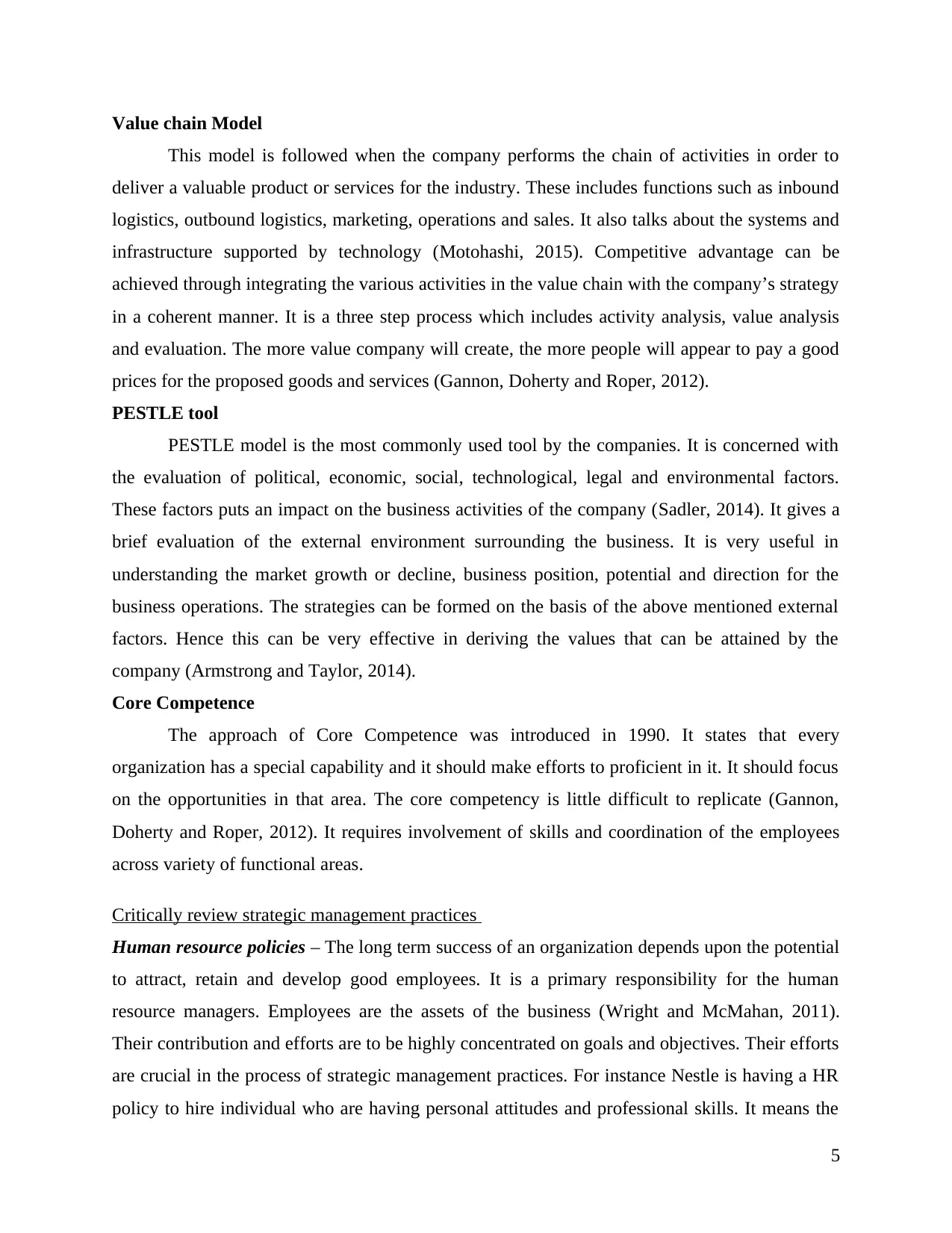
Value chain Model
This model is followed when the company performs the chain of activities in order to
deliver a valuable product or services for the industry. These includes functions such as inbound
logistics, outbound logistics, marketing, operations and sales. It also talks about the systems and
infrastructure supported by technology (Motohashi, 2015). Competitive advantage can be
achieved through integrating the various activities in the value chain with the company’s strategy
in a coherent manner. It is a three step process which includes activity analysis, value analysis
and evaluation. The more value company will create, the more people will appear to pay a good
prices for the proposed goods and services (Gannon, Doherty and Roper, 2012).
PESTLE tool
PESTLE model is the most commonly used tool by the companies. It is concerned with
the evaluation of political, economic, social, technological, legal and environmental factors.
These factors puts an impact on the business activities of the company (Sadler, 2014). It gives a
brief evaluation of the external environment surrounding the business. It is very useful in
understanding the market growth or decline, business position, potential and direction for the
business operations. The strategies can be formed on the basis of the above mentioned external
factors. Hence this can be very effective in deriving the values that can be attained by the
company (Armstrong and Taylor, 2014).
Core Competence
The approach of Core Competence was introduced in 1990. It states that every
organization has a special capability and it should make efforts to proficient in it. It should focus
on the opportunities in that area. The core competency is little difficult to replicate (Gannon,
Doherty and Roper, 2012). It requires involvement of skills and coordination of the employees
across variety of functional areas.
Critically review strategic management practices
Human resource policies – The long term success of an organization depends upon the potential
to attract, retain and develop good employees. It is a primary responsibility for the human
resource managers. Employees are the assets of the business (Wright and McMahan, 2011).
Their contribution and efforts are to be highly concentrated on goals and objectives. Their efforts
are crucial in the process of strategic management practices. For instance Nestle is having a HR
policy to hire individual who are having personal attitudes and professional skills. It means the
5
This model is followed when the company performs the chain of activities in order to
deliver a valuable product or services for the industry. These includes functions such as inbound
logistics, outbound logistics, marketing, operations and sales. It also talks about the systems and
infrastructure supported by technology (Motohashi, 2015). Competitive advantage can be
achieved through integrating the various activities in the value chain with the company’s strategy
in a coherent manner. It is a three step process which includes activity analysis, value analysis
and evaluation. The more value company will create, the more people will appear to pay a good
prices for the proposed goods and services (Gannon, Doherty and Roper, 2012).
PESTLE tool
PESTLE model is the most commonly used tool by the companies. It is concerned with
the evaluation of political, economic, social, technological, legal and environmental factors.
These factors puts an impact on the business activities of the company (Sadler, 2014). It gives a
brief evaluation of the external environment surrounding the business. It is very useful in
understanding the market growth or decline, business position, potential and direction for the
business operations. The strategies can be formed on the basis of the above mentioned external
factors. Hence this can be very effective in deriving the values that can be attained by the
company (Armstrong and Taylor, 2014).
Core Competence
The approach of Core Competence was introduced in 1990. It states that every
organization has a special capability and it should make efforts to proficient in it. It should focus
on the opportunities in that area. The core competency is little difficult to replicate (Gannon,
Doherty and Roper, 2012). It requires involvement of skills and coordination of the employees
across variety of functional areas.
Critically review strategic management practices
Human resource policies – The long term success of an organization depends upon the potential
to attract, retain and develop good employees. It is a primary responsibility for the human
resource managers. Employees are the assets of the business (Wright and McMahan, 2011).
Their contribution and efforts are to be highly concentrated on goals and objectives. Their efforts
are crucial in the process of strategic management practices. For instance Nestle is having a HR
policy to hire individual who are having personal attitudes and professional skills. It means the
5
Paraphrase This Document
Need a fresh take? Get an instant paraphrase of this document with our AI Paraphraser
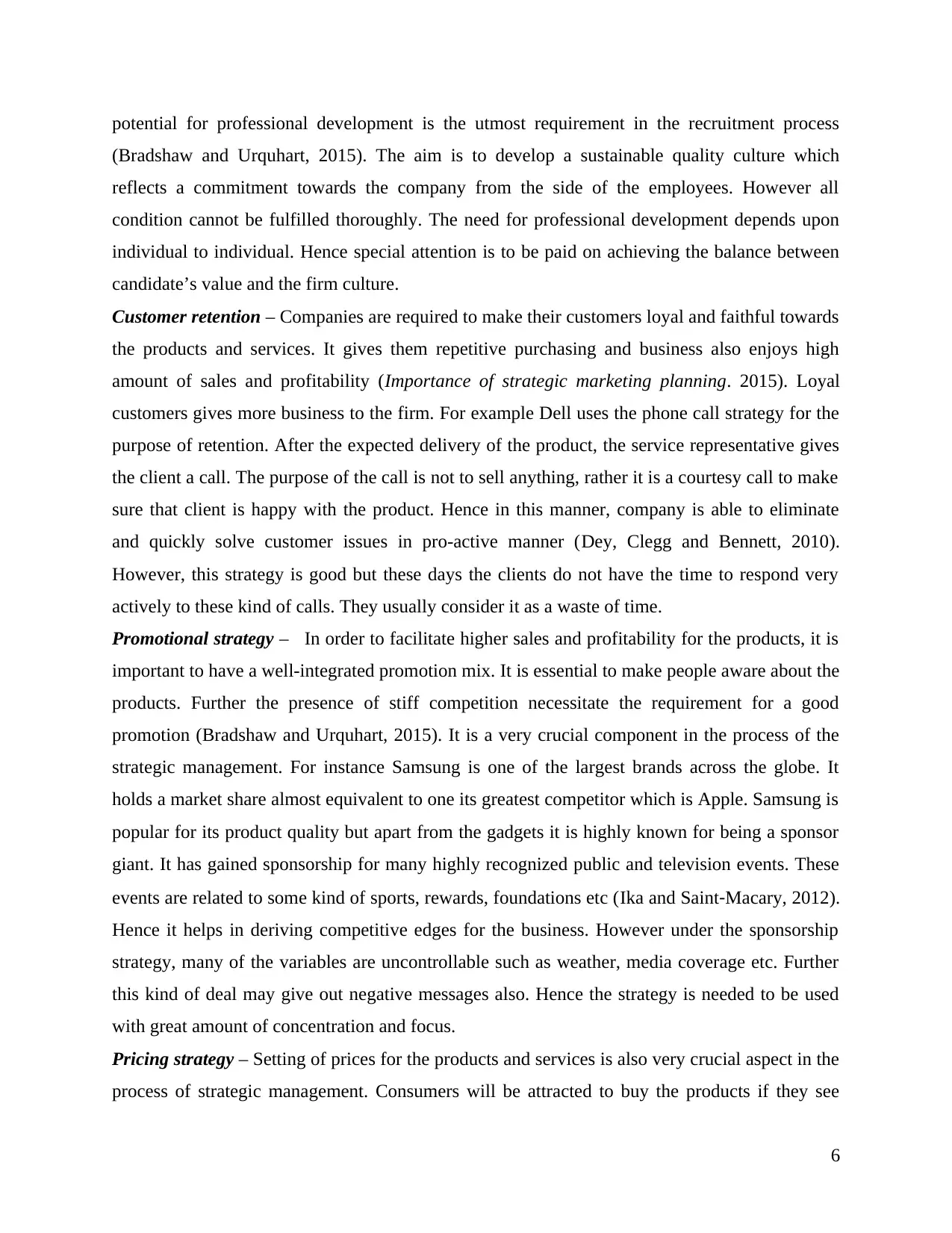
potential for professional development is the utmost requirement in the recruitment process
(Bradshaw and Urquhart, 2015). The aim is to develop a sustainable quality culture which
reflects a commitment towards the company from the side of the employees. However all
condition cannot be fulfilled thoroughly. The need for professional development depends upon
individual to individual. Hence special attention is to be paid on achieving the balance between
candidate’s value and the firm culture.
Customer retention – Companies are required to make their customers loyal and faithful towards
the products and services. It gives them repetitive purchasing and business also enjoys high
amount of sales and profitability (Importance of strategic marketing planning. 2015). Loyal
customers gives more business to the firm. For example Dell uses the phone call strategy for the
purpose of retention. After the expected delivery of the product, the service representative gives
the client a call. The purpose of the call is not to sell anything, rather it is a courtesy call to make
sure that client is happy with the product. Hence in this manner, company is able to eliminate
and quickly solve customer issues in pro-active manner (Dey, Clegg and Bennett, 2010).
However, this strategy is good but these days the clients do not have the time to respond very
actively to these kind of calls. They usually consider it as a waste of time.
Promotional strategy – In order to facilitate higher sales and profitability for the products, it is
important to have a well-integrated promotion mix. It is essential to make people aware about the
products. Further the presence of stiff competition necessitate the requirement for a good
promotion (Bradshaw and Urquhart, 2015). It is a very crucial component in the process of the
strategic management. For instance Samsung is one of the largest brands across the globe. It
holds a market share almost equivalent to one its greatest competitor which is Apple. Samsung is
popular for its product quality but apart from the gadgets it is highly known for being a sponsor
giant. It has gained sponsorship for many highly recognized public and television events. These
events are related to some kind of sports, rewards, foundations etc (Ika and Saint‐Macary, 2012).
Hence it helps in deriving competitive edges for the business. However under the sponsorship
strategy, many of the variables are uncontrollable such as weather, media coverage etc. Further
this kind of deal may give out negative messages also. Hence the strategy is needed to be used
with great amount of concentration and focus.
Pricing strategy – Setting of prices for the products and services is also very crucial aspect in the
process of strategic management. Consumers will be attracted to buy the products if they see
6
(Bradshaw and Urquhart, 2015). The aim is to develop a sustainable quality culture which
reflects a commitment towards the company from the side of the employees. However all
condition cannot be fulfilled thoroughly. The need for professional development depends upon
individual to individual. Hence special attention is to be paid on achieving the balance between
candidate’s value and the firm culture.
Customer retention – Companies are required to make their customers loyal and faithful towards
the products and services. It gives them repetitive purchasing and business also enjoys high
amount of sales and profitability (Importance of strategic marketing planning. 2015). Loyal
customers gives more business to the firm. For example Dell uses the phone call strategy for the
purpose of retention. After the expected delivery of the product, the service representative gives
the client a call. The purpose of the call is not to sell anything, rather it is a courtesy call to make
sure that client is happy with the product. Hence in this manner, company is able to eliminate
and quickly solve customer issues in pro-active manner (Dey, Clegg and Bennett, 2010).
However, this strategy is good but these days the clients do not have the time to respond very
actively to these kind of calls. They usually consider it as a waste of time.
Promotional strategy – In order to facilitate higher sales and profitability for the products, it is
important to have a well-integrated promotion mix. It is essential to make people aware about the
products. Further the presence of stiff competition necessitate the requirement for a good
promotion (Bradshaw and Urquhart, 2015). It is a very crucial component in the process of the
strategic management. For instance Samsung is one of the largest brands across the globe. It
holds a market share almost equivalent to one its greatest competitor which is Apple. Samsung is
popular for its product quality but apart from the gadgets it is highly known for being a sponsor
giant. It has gained sponsorship for many highly recognized public and television events. These
events are related to some kind of sports, rewards, foundations etc (Ika and Saint‐Macary, 2012).
Hence it helps in deriving competitive edges for the business. However under the sponsorship
strategy, many of the variables are uncontrollable such as weather, media coverage etc. Further
this kind of deal may give out negative messages also. Hence the strategy is needed to be used
with great amount of concentration and focus.
Pricing strategy – Setting of prices for the products and services is also very crucial aspect in the
process of strategic management. Consumers will be attracted to buy the products if they see
6
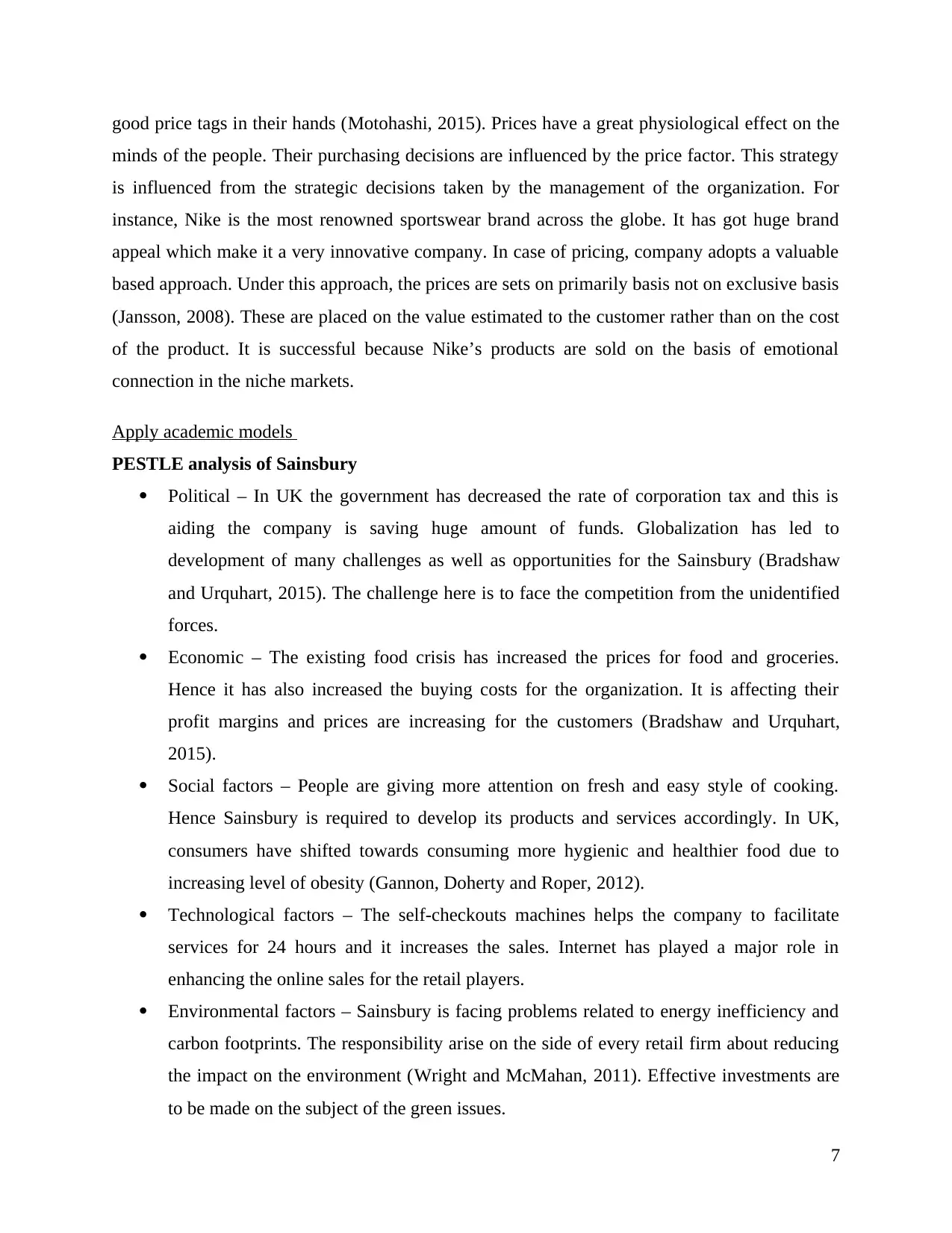
good price tags in their hands (Motohashi, 2015). Prices have a great physiological effect on the
minds of the people. Their purchasing decisions are influenced by the price factor. This strategy
is influenced from the strategic decisions taken by the management of the organization. For
instance, Nike is the most renowned sportswear brand across the globe. It has got huge brand
appeal which make it a very innovative company. In case of pricing, company adopts a valuable
based approach. Under this approach, the prices are sets on primarily basis not on exclusive basis
(Jansson, 2008). These are placed on the value estimated to the customer rather than on the cost
of the product. It is successful because Nike’s products are sold on the basis of emotional
connection in the niche markets.
Apply academic models
PESTLE analysis of Sainsbury
Political – In UK the government has decreased the rate of corporation tax and this is
aiding the company is saving huge amount of funds. Globalization has led to
development of many challenges as well as opportunities for the Sainsbury (Bradshaw
and Urquhart, 2015). The challenge here is to face the competition from the unidentified
forces.
Economic – The existing food crisis has increased the prices for food and groceries.
Hence it has also increased the buying costs for the organization. It is affecting their
profit margins and prices are increasing for the customers (Bradshaw and Urquhart,
2015).
Social factors – People are giving more attention on fresh and easy style of cooking.
Hence Sainsbury is required to develop its products and services accordingly. In UK,
consumers have shifted towards consuming more hygienic and healthier food due to
increasing level of obesity (Gannon, Doherty and Roper, 2012).
Technological factors – The self-checkouts machines helps the company to facilitate
services for 24 hours and it increases the sales. Internet has played a major role in
enhancing the online sales for the retail players.
Environmental factors – Sainsbury is facing problems related to energy inefficiency and
carbon footprints. The responsibility arise on the side of every retail firm about reducing
the impact on the environment (Wright and McMahan, 2011). Effective investments are
to be made on the subject of the green issues.
7
minds of the people. Their purchasing decisions are influenced by the price factor. This strategy
is influenced from the strategic decisions taken by the management of the organization. For
instance, Nike is the most renowned sportswear brand across the globe. It has got huge brand
appeal which make it a very innovative company. In case of pricing, company adopts a valuable
based approach. Under this approach, the prices are sets on primarily basis not on exclusive basis
(Jansson, 2008). These are placed on the value estimated to the customer rather than on the cost
of the product. It is successful because Nike’s products are sold on the basis of emotional
connection in the niche markets.
Apply academic models
PESTLE analysis of Sainsbury
Political – In UK the government has decreased the rate of corporation tax and this is
aiding the company is saving huge amount of funds. Globalization has led to
development of many challenges as well as opportunities for the Sainsbury (Bradshaw
and Urquhart, 2015). The challenge here is to face the competition from the unidentified
forces.
Economic – The existing food crisis has increased the prices for food and groceries.
Hence it has also increased the buying costs for the organization. It is affecting their
profit margins and prices are increasing for the customers (Bradshaw and Urquhart,
2015).
Social factors – People are giving more attention on fresh and easy style of cooking.
Hence Sainsbury is required to develop its products and services accordingly. In UK,
consumers have shifted towards consuming more hygienic and healthier food due to
increasing level of obesity (Gannon, Doherty and Roper, 2012).
Technological factors – The self-checkouts machines helps the company to facilitate
services for 24 hours and it increases the sales. Internet has played a major role in
enhancing the online sales for the retail players.
Environmental factors – Sainsbury is facing problems related to energy inefficiency and
carbon footprints. The responsibility arise on the side of every retail firm about reducing
the impact on the environment (Wright and McMahan, 2011). Effective investments are
to be made on the subject of the green issues.
7
⊘ This is a preview!⊘
Do you want full access?
Subscribe today to unlock all pages.

Trusted by 1+ million students worldwide
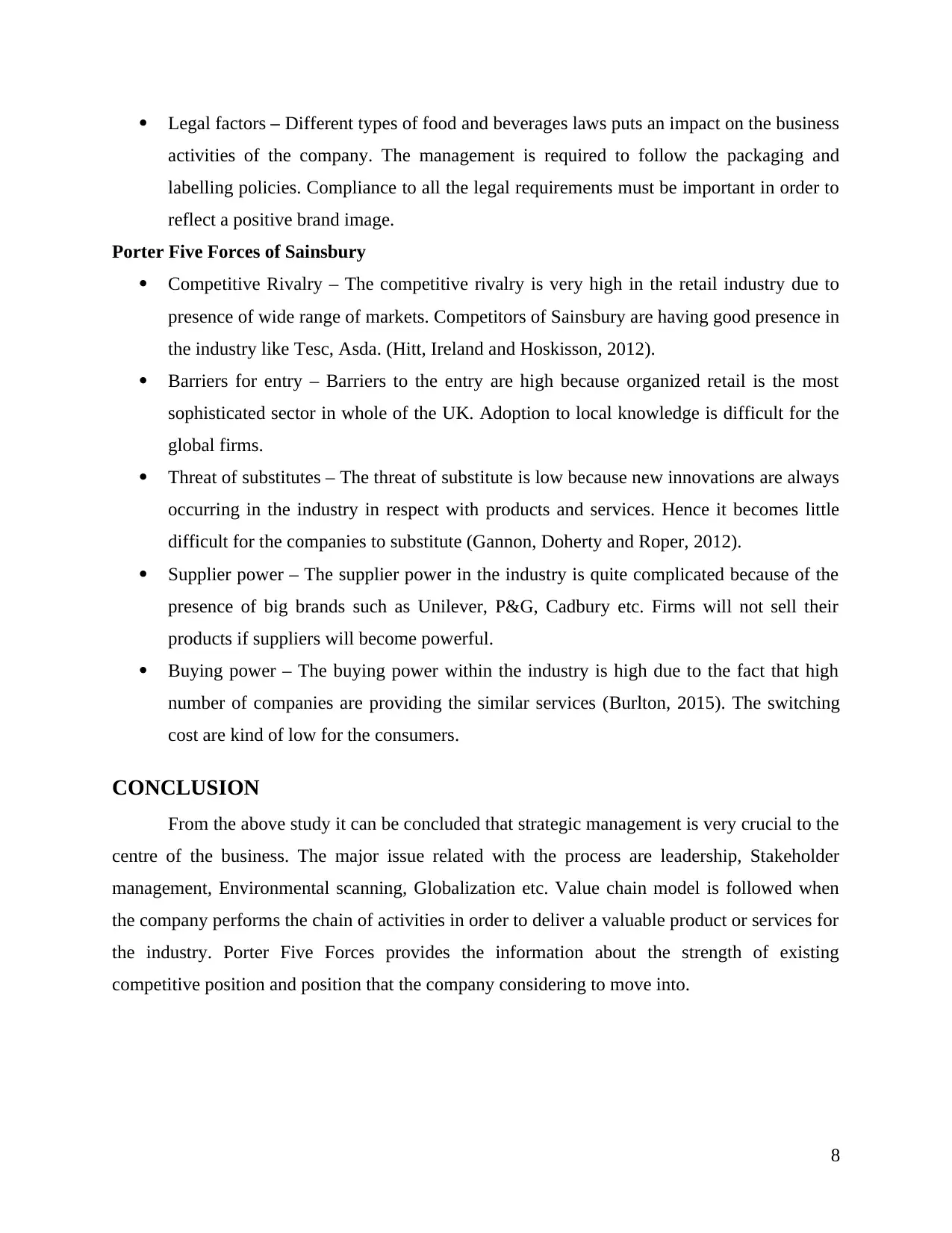
Legal factors – Different types of food and beverages laws puts an impact on the business
activities of the company. The management is required to follow the packaging and
labelling policies. Compliance to all the legal requirements must be important in order to
reflect a positive brand image.
Porter Five Forces of Sainsbury
Competitive Rivalry – The competitive rivalry is very high in the retail industry due to
presence of wide range of markets. Competitors of Sainsbury are having good presence in
the industry like Tesc, Asda. (Hitt, Ireland and Hoskisson, 2012).
Barriers for entry – Barriers to the entry are high because organized retail is the most
sophisticated sector in whole of the UK. Adoption to local knowledge is difficult for the
global firms.
Threat of substitutes – The threat of substitute is low because new innovations are always
occurring in the industry in respect with products and services. Hence it becomes little
difficult for the companies to substitute (Gannon, Doherty and Roper, 2012).
Supplier power – The supplier power in the industry is quite complicated because of the
presence of big brands such as Unilever, P&G, Cadbury etc. Firms will not sell their
products if suppliers will become powerful.
Buying power – The buying power within the industry is high due to the fact that high
number of companies are providing the similar services (Burlton, 2015). The switching
cost are kind of low for the consumers.
CONCLUSION
From the above study it can be concluded that strategic management is very crucial to the
centre of the business. The major issue related with the process are leadership, Stakeholder
management, Environmental scanning, Globalization etc. Value chain model is followed when
the company performs the chain of activities in order to deliver a valuable product or services for
the industry. Porter Five Forces provides the information about the strength of existing
competitive position and position that the company considering to move into.
8
activities of the company. The management is required to follow the packaging and
labelling policies. Compliance to all the legal requirements must be important in order to
reflect a positive brand image.
Porter Five Forces of Sainsbury
Competitive Rivalry – The competitive rivalry is very high in the retail industry due to
presence of wide range of markets. Competitors of Sainsbury are having good presence in
the industry like Tesc, Asda. (Hitt, Ireland and Hoskisson, 2012).
Barriers for entry – Barriers to the entry are high because organized retail is the most
sophisticated sector in whole of the UK. Adoption to local knowledge is difficult for the
global firms.
Threat of substitutes – The threat of substitute is low because new innovations are always
occurring in the industry in respect with products and services. Hence it becomes little
difficult for the companies to substitute (Gannon, Doherty and Roper, 2012).
Supplier power – The supplier power in the industry is quite complicated because of the
presence of big brands such as Unilever, P&G, Cadbury etc. Firms will not sell their
products if suppliers will become powerful.
Buying power – The buying power within the industry is high due to the fact that high
number of companies are providing the similar services (Burlton, 2015). The switching
cost are kind of low for the consumers.
CONCLUSION
From the above study it can be concluded that strategic management is very crucial to the
centre of the business. The major issue related with the process are leadership, Stakeholder
management, Environmental scanning, Globalization etc. Value chain model is followed when
the company performs the chain of activities in order to deliver a valuable product or services for
the industry. Porter Five Forces provides the information about the strength of existing
competitive position and position that the company considering to move into.
8
Paraphrase This Document
Need a fresh take? Get an instant paraphrase of this document with our AI Paraphraser
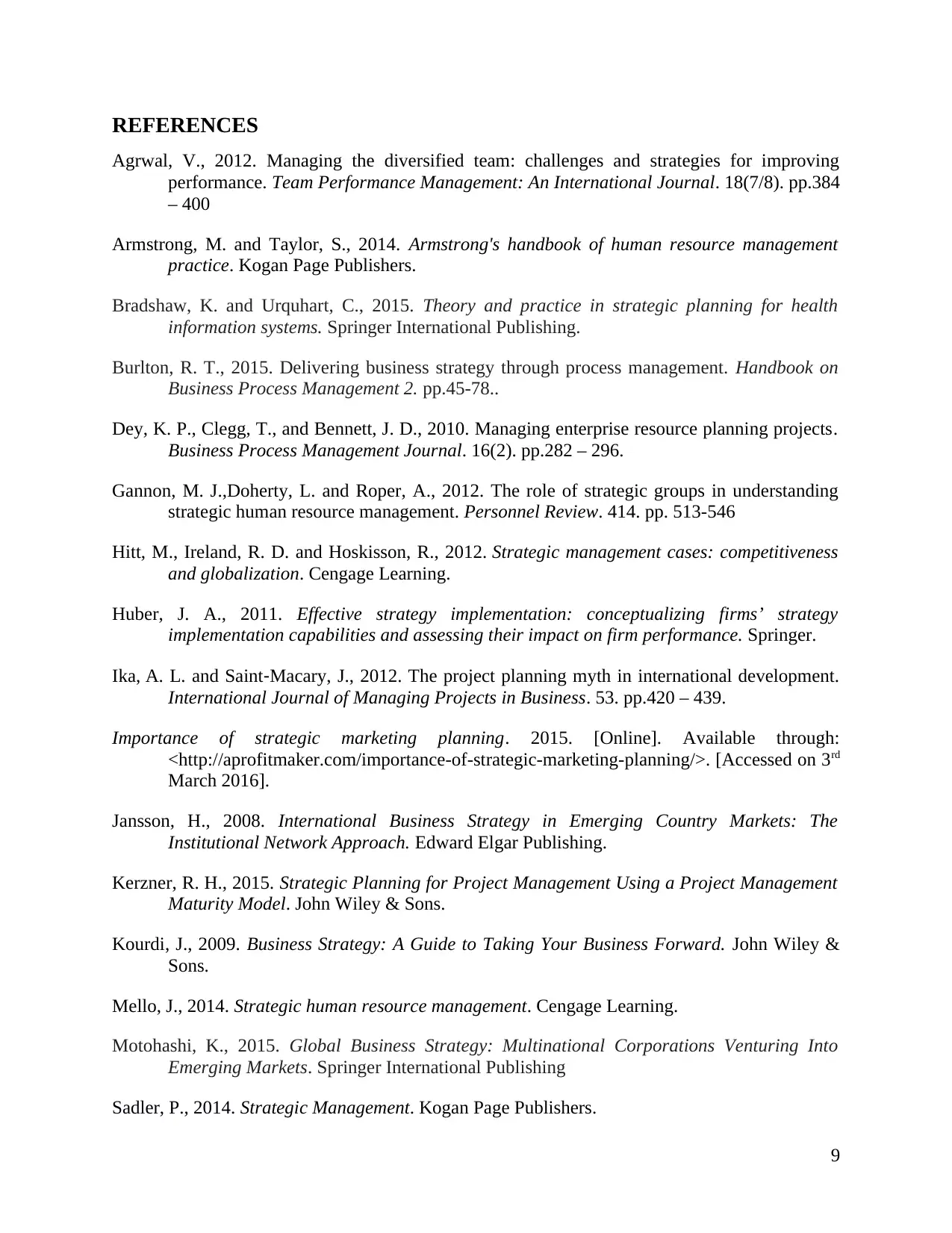
REFERENCES
Agrwal, V., 2012. Managing the diversified team: challenges and strategies for improving
performance. Team Performance Management: An International Journal. 18(7/8). pp.384
– 400
Armstrong, M. and Taylor, S., 2014. Armstrong's handbook of human resource management
practice. Kogan Page Publishers.
Bradshaw, K. and Urquhart, C., 2015. Theory and practice in strategic planning for health
information systems. Springer International Publishing.
Burlton, R. T., 2015. Delivering business strategy through process management. Handbook on
Business Process Management 2. pp.45-78..
Dey, K. P., Clegg, T., and Bennett, J. D., 2010. Managing enterprise resource planning projects.
Business Process Management Journal. 16(2). pp.282 – 296.
Gannon, M. J.,Doherty, L. and Roper, A., 2012. The role of strategic groups in understanding
strategic human resource management. Personnel Review. 414. pp. 513-546
Hitt, M., Ireland, R. D. and Hoskisson, R., 2012. Strategic management cases: competitiveness
and globalization. Cengage Learning.
Huber, J. A., 2011. Effective strategy implementation: conceptualizing firms’ strategy
implementation capabilities and assessing their impact on firm performance. Springer.
Ika, A. L. and Saint‐Macary, J., 2012. The project planning myth in international development.
International Journal of Managing Projects in Business. 53. pp.420 – 439.
Importance of strategic marketing planning. 2015. [Online]. Available through:
<http://aprofitmaker.com/importance-of-strategic-marketing-planning/>. [Accessed on 3rd
March 2016].
Jansson, H., 2008. International Business Strategy in Emerging Country Markets: The
Institutional Network Approach. Edward Elgar Publishing.
Kerzner, R. H., 2015. Strategic Planning for Project Management Using a Project Management
Maturity Model. John Wiley & Sons.
Kourdi, J., 2009. Business Strategy: A Guide to Taking Your Business Forward. John Wiley &
Sons.
Mello, J., 2014. Strategic human resource management. Cengage Learning.
Motohashi, K., 2015. Global Business Strategy: Multinational Corporations Venturing Into
Emerging Markets. Springer International Publishing
Sadler, P., 2014. Strategic Management. Kogan Page Publishers.
9
Agrwal, V., 2012. Managing the diversified team: challenges and strategies for improving
performance. Team Performance Management: An International Journal. 18(7/8). pp.384
– 400
Armstrong, M. and Taylor, S., 2014. Armstrong's handbook of human resource management
practice. Kogan Page Publishers.
Bradshaw, K. and Urquhart, C., 2015. Theory and practice in strategic planning for health
information systems. Springer International Publishing.
Burlton, R. T., 2015. Delivering business strategy through process management. Handbook on
Business Process Management 2. pp.45-78..
Dey, K. P., Clegg, T., and Bennett, J. D., 2010. Managing enterprise resource planning projects.
Business Process Management Journal. 16(2). pp.282 – 296.
Gannon, M. J.,Doherty, L. and Roper, A., 2012. The role of strategic groups in understanding
strategic human resource management. Personnel Review. 414. pp. 513-546
Hitt, M., Ireland, R. D. and Hoskisson, R., 2012. Strategic management cases: competitiveness
and globalization. Cengage Learning.
Huber, J. A., 2011. Effective strategy implementation: conceptualizing firms’ strategy
implementation capabilities and assessing their impact on firm performance. Springer.
Ika, A. L. and Saint‐Macary, J., 2012. The project planning myth in international development.
International Journal of Managing Projects in Business. 53. pp.420 – 439.
Importance of strategic marketing planning. 2015. [Online]. Available through:
<http://aprofitmaker.com/importance-of-strategic-marketing-planning/>. [Accessed on 3rd
March 2016].
Jansson, H., 2008. International Business Strategy in Emerging Country Markets: The
Institutional Network Approach. Edward Elgar Publishing.
Kerzner, R. H., 2015. Strategic Planning for Project Management Using a Project Management
Maturity Model. John Wiley & Sons.
Kourdi, J., 2009. Business Strategy: A Guide to Taking Your Business Forward. John Wiley &
Sons.
Mello, J., 2014. Strategic human resource management. Cengage Learning.
Motohashi, K., 2015. Global Business Strategy: Multinational Corporations Venturing Into
Emerging Markets. Springer International Publishing
Sadler, P., 2014. Strategic Management. Kogan Page Publishers.
9
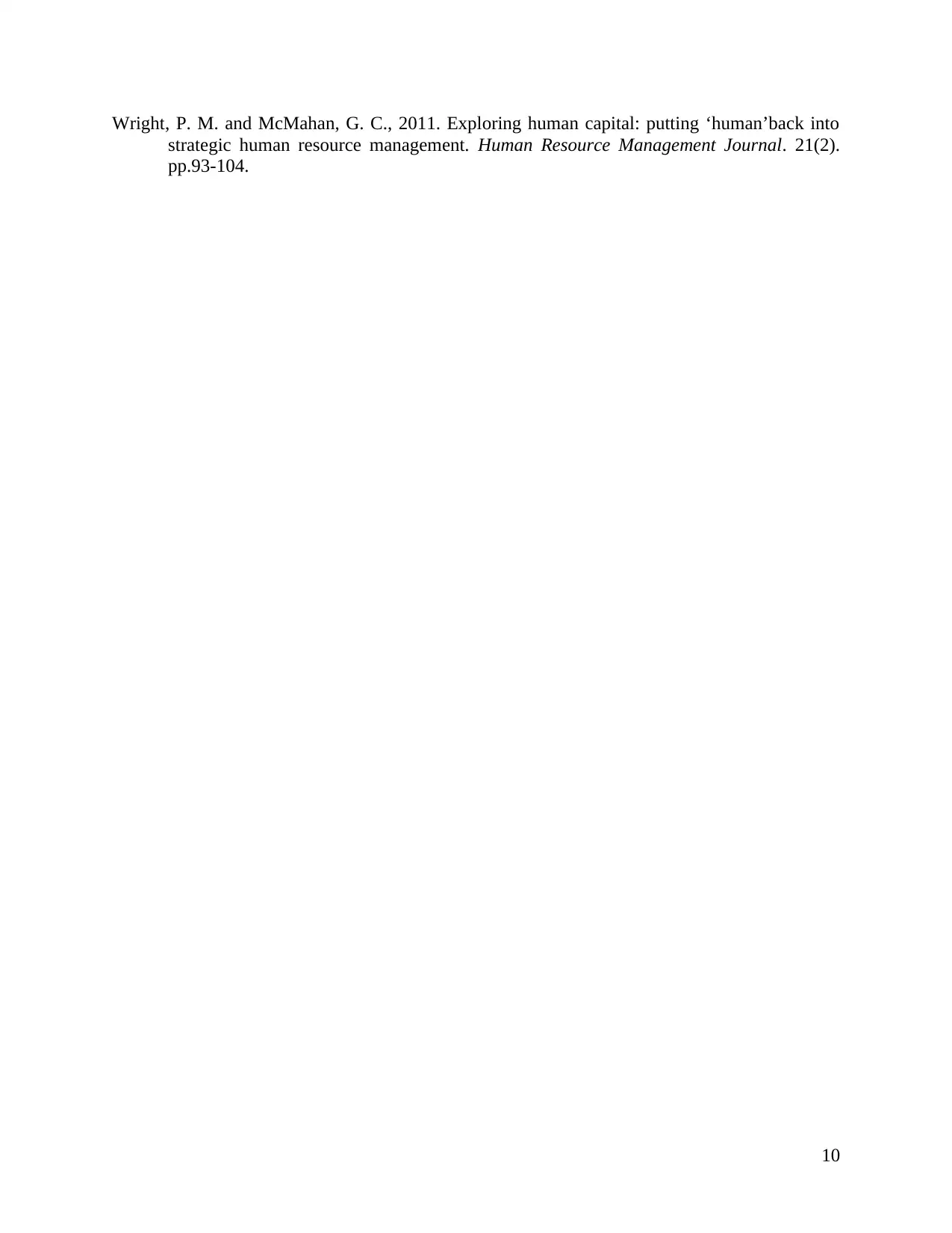
Wright, P. M. and McMahan, G. C., 2011. Exploring human capital: putting ‘human’back into
strategic human resource management. Human Resource Management Journal. 21(2).
pp.93-104.
10
strategic human resource management. Human Resource Management Journal. 21(2).
pp.93-104.
10
⊘ This is a preview!⊘
Do you want full access?
Subscribe today to unlock all pages.

Trusted by 1+ million students worldwide
1 out of 12
Related Documents
Your All-in-One AI-Powered Toolkit for Academic Success.
+13062052269
info@desklib.com
Available 24*7 on WhatsApp / Email
![[object Object]](/_next/static/media/star-bottom.7253800d.svg)
Unlock your academic potential
Copyright © 2020–2025 A2Z Services. All Rights Reserved. Developed and managed by ZUCOL.




